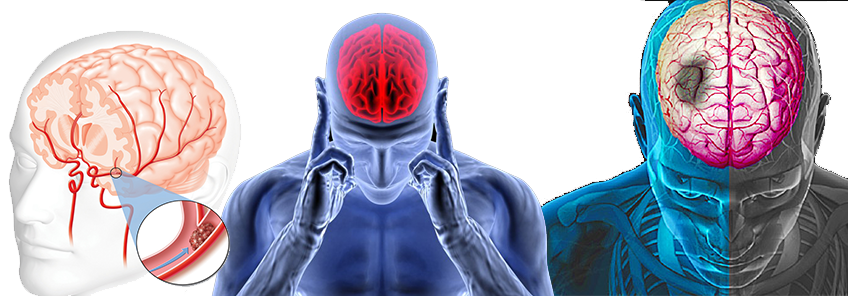Stroke

- a slurred speech or difficulty speaking;
- inability to move certain parts of the body;
- numbness of the face, arm or leg;
- drooping of one side of the mouth;
- difficulty seeing with one or both eyes;
- headache;
- difficulty walking and balancing;
- dizziness, fainting;
- patients may lose consciousness if the stroke is massive.
- Ischemic: Ischemic stroke occurs when a blood clot blocks the blood supply to the brain. The clot may be formed within the blood vessels of the brain or the clot can form outside the brain, mainly in the heart and large vessels, that is swept through the circulation to the brain. About 85% of all strokes are ischemic stroke.
- Hemorrhagic. In hemorrhagic stroke, blood vessels in the brain rupture and bleed into the brain tissue causing death of the brain cells. Poorly-controlled hypertension and a brain aneurysm (ballooning of the blood vessel secondary to a defect in the wall of the blood vessel that makes it weak and prone to rupture) are two most common causes of hemorrhagic stroke. Other causes of hemorrhagic stroke are overtreatment with blood thinners (anticoagulants) and blood disorder that causes low platelets. Hemorrhagic stroke can be further divided into intraparenchymal bleed and subarachnoid bleed, which are treated differently and have different prognosis.
- Modifiable risk factors:
- Lifestyle factors: Overweight/obesity, physical inactivity, heavy drinking and use of illicit drugs like cocaine and amphetamine, cigarette smoking.
- Medical risk factors: high blood pressure, high blood cholesterol, obstructive sleep apnea, diabetes and other cardiovascular diseases.
- Non modifiable risk factors:
- Old age > 55 years;
- men are at higher risk than women;
- family history of stroke, TIA or heart attacks;
- African americans have higher risk of stroke compared to other races.
- Blood tests to evaluate blood glucose, lipid profile, coagulation profile and various other tests.
- Carotid ultrasound to assess large blood vessels in your neck.
- Echocardiography to assess your heart.
Stroke is a medical emergency. It occurs when the blood supply to the brain is severely compromised or suddenly cut off. As a result, the brain cells begin to die due to the lack of oxygen and nutrients. A permanent damage can result if blood flow is not restored promptly. If the blood flow is restored prior to a significant amount of cell death has occurred, you will experience only transient symptoms. This condition is known as Transient Ischemic Attack (TIA) or a “mini-stroke”. However, TIA is not a benign condition. It is an warning sign that needs an urgent response as it can quickly develop into a full-blown stroke.
What are the symptoms of stroke?
Patients with stroke often do not seek medical help on their own, because they may not be in pain or they may not be able to appreciate that something has gone wrong. Often, a family member or an accompanying person is the first to notice the symptoms. The patient may suffer from variety of symptoms such as:
What are the different types of stroke?
There are two types of stroke:
What are the risk factors for stroke?
The risk factors that increase your risk of stroke are similar to the risk factors that increase your risk of a heart attack. These risk factors can be divided into modifiable and nonmodifiable risk factors. By controlling the modifiable risk factors, up to 50% of stroke can be prevented.
How is stroke diagnosed?
Stroke is diagnosed based on the presence of one of the symptoms discussed above and physical examination demonstrating a weakness on some part of the body. To confirm the diagnosis, the type of stroke is identified and other conditions that may mimic a stroke (e.g. brain tumor) are ruled out. Your doctor will order a CT scan or an MRI of the brain or a cerebral angiogram. Your doctor will also order some of the following tests to identify the underlying cause of the stroke:
How do you treat stroke?
Management of stroke depends on the types of stroke.
Treatment of ischemic stroke is aimed towards quickly restoring the blood flow to the brain. This is achieved by injecting “clot busting” medicines into the vein if you reach hospital within 4-6 hours of onset of symptoms. If more time has elapsed since, your chance of full recovery will be dramatically reduced. You will be given aspirin to reduce further risk of stroke. Doctors may recommend other procedures such as, carotid endarterectomy, balloon angioplasty and stent placements to open the narrowed arteries with the aim of reducing your risk of future strokes.
Treatment of hemorrhagic stroke focuses on control of the bleeding and decreasing pressure from building up inside the brain. Drugs to lower the pressure are given to prevent further bleeding. If the area bleeding is large, surgery may be performed in the brain itself to remove the blood and relieve pressure. If the bleeding is from an aneurysm, surgery is performed to remove the aneurysm. In subarachnoid bleeding, a medicine called nimodipine is given to prevent further spasm of the blood vessels.
As mentioned above, if you experience a “mini-stroke” you need to seek urgent medical care.
Rehabilitation and physical therapy is an integral part of stroke care. Patients with stroke often have problem with breathing, swallowing, balancing and vision. A rigorous rehabilitation can lead to significant regaining of strength and recovery of functions. Stroke rehabilitation is a multidisciplinary approach consisting of a neurologist, nurse, dietitian, physiotherapist, speech therapist and a psychologist or a psychiatrist.



Send us your feedback on this article